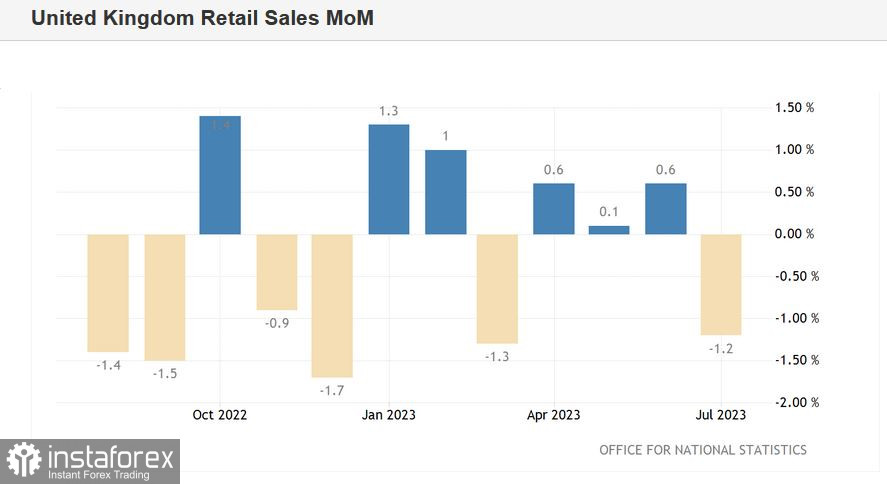The British pound is losing ground against the US dollar at the end of the trading week following three consecutive days of growth. The market appreciated the British currency after assessing conflicting macroeconomic reports released in the UK on Tuesday and Wednesday. As a result, the GBP/USD pair not only returned to 1.2700 but also tested the resistance level at 1.2780 (the middle line of the Bollinger Bands indicator on the D1 time frame). However, today the initiative was once again taken by sellers, temporarily pulling the price back to 1.2600. On Friday, the downtrend wiped out all the gains of GBP/USD buyers, potentially causing the pair to return to its opening price by the end of the week (1.2690). Considering the strength of the downward movement, the weekly candlestick might turn out bearish.
The British pound initially strengthened its position on rather shaky grounds. Key data on the labor market and inflation were contradictory, pushing the GBP/USD pair higher, thou, it was quite unpredictable.
On the British currency side, wage indicators and the core consumer price index played a significant role. The core CPI remained at the May level in June (6.9%), contrary to expectations of a decrease to 6.8%. Regarding wage indicators, the average earnings level increased by 8.2% in June (including bonuses), reaching its highest value since August 2021. Excluding bonuses, wages grew by 7.8%, marking a record growth since the calculation of this indicator began in 2001.
Thanks to these figures, the pound solidified its position across the market and reached the 1.2786 target against the US dollar. However, pound buyers failed to settle the price above the resistance level of 1.2780, the middle line of the Bollinger Bands indicator on the D1 time frame. This was because all the other components of the aforementioned macroeconomic releases were not in favor of the British currency.
For instance, the unemployment rate increased again, reaching 4.2% (the second consecutive month of growth). The number of unemployment claims rose by nearly 30,000 (against a forecasted increase of 19,000), marking the worst result since January 2021. The overall consumer price index posted -0.4% on a monthly basis, entering negative territory for the first time since January this year. The retail price index showed -0.6% (forecasted to decline to 0.7%). This component of the report entered negative territory for the first time since January 2021. Moreover, this is the weakest result since February 2019. The producer price index for purchases also entered the red zone, both on a monthly and yearly basis.
Can these results pave the way for a sustainable bullish trend for traders? The upward momentum of GBP/USD initially had an unsupported nature. Today's retail trade release only added to the picture that initially did not favor the British currency.
For instance, retail trade volume in the UK, including fuel prices, decreased by 1.2% in July on a monthly basis, against a forecasted decline of 0.6%, the worst result since March this year, and by 3.2% on an annual basis against a forecasted decline of 2.1%. The core retail sales index, excluding fuel prices, also entered the red zone. On a monthly basis, the indicator decreased to -1.4%, and on an annual basis, it dropped to -3.4%, the worst result since March this year.


Considering these disappointing figures, it is not surprising that GBP/USD buyers have lost their previously gained positions today. However, the development of the downward movement is also uncertain, given the general weakening of the greenback. Therefore, it is better to postpone short positions until bears fix the price below 1.2700.
From a technical perspective, the GBP/USD pair is attempting to hold below the support level of 1.2710, the Tenken-sen line on the daily chart, coinciding with the lower border of the Kumo cloud. If traders manage to drag the price below this target, the Ichimoku indicator may form a bearish Line Parade signal, indicating the priority of short positions. Overall, considering sales is reasonable only after GBP/USD sellers manage to push the price to 1.2600. Currently, buyers of the pair are attempting to regain momentum, benefiting from the decrease in the US dollar index. Therefore, selling from current levels remains risky. However, the fundamental background does not support the development of a sustainable bullish trend, so long positions might not be advisable.
 English
English 
 Русский
Русский Bahasa Indonesia
Bahasa Indonesia Bahasa Malay
Bahasa Malay ไทย
ไทย Español
Español Deutsch
Deutsch Български
Български Français
Français Tiếng Việt
Tiếng Việt 中文
中文 বাংলা
বাংলা हिन्दी
हिन्दी Čeština
Čeština Українська
Українська Română
Română

